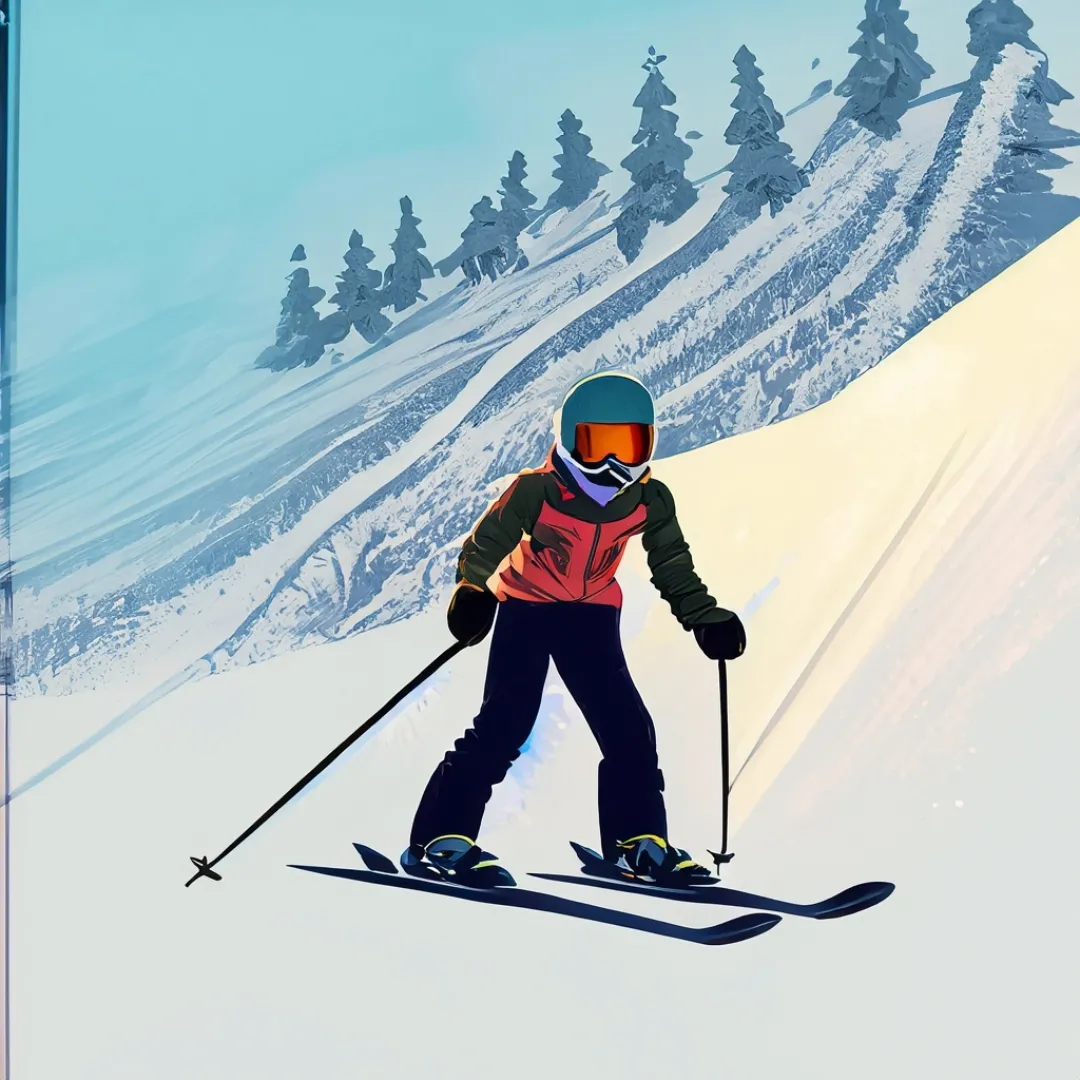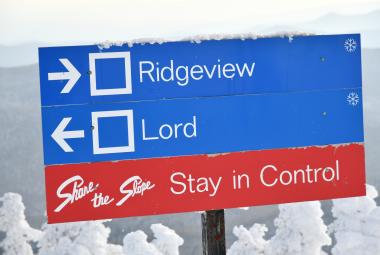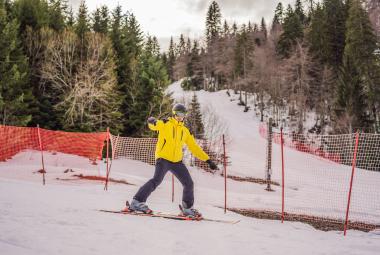Ready to learn to ski this winter? There's plenty to learn about, including some important first-time tips.
It's never too late to get started skiing and join so many other people that have fallen in love with this downhill sport. You don't have to become an expert to enjoy it. The beauty of skiing is it's at-your-own-pace kind of activity, and you can indulge in as little or as much of it as you like.
Being new to skiing isn't easy, but with the right advice and mindset, you can tackle the challenges and enjoy a brand new winter hobby.
1. Take a lesson

As an adult, it can feel strange to go in for a lesson, especially when ski school is dominated by kids.
Trust me, the lessons are worth it to get yourself in the right place to start things off.
One of the biggest mistakes you can make is learn the wrong technique or approach because it's difficult to unlearn something and then re-learn a different approach.
Ski schools are very welcoming and they've seen all sorts of skiers, many of which who were likely less coordinated than you! Leave your ego at the base of the mountain and come in ready to fall (gracefully) and learn how to stay on your skis the right way from the first day.
2. Rent skis before you commit to the sport

It may seem like the best idea to buy the best gear possible so you can start off skiing with all the advantages out there, but buying skis instead of renting when you're brand new is actually a mistake.
Think of learning to ski like learning to ride a bike: you can use just about any bike to learn to ride, and the same is true for skis.
Not only will you learn to ski with rentals, the ski rental equipment is usually more than adequate for a newbie.
Moreover, renting also protects yourself just in case you decide skiing isn't right for you.
3. Buy the right socks
Socks are probably something most new skiers never think about, but the right pair of socks makes a big difference.
Wearing the same socks you'd wear every day is an easy trap to fall into because ski socks are so important to being comfortable.
First and foremost, it's going to be cold on the mountain. Ski boots are designed to help you control your skis, not protect your feet from the elements.
4. Lean forward in your boots

Mastery of skiing lays with being in control of your skis, and one mantra you'll learn is to lean forward.
This seems counterintuitive because your natural instinct is to lean back to try to gain more balance, but this is a common mistake.
You want to control the skis instead of the skis controlling you.
Leaning forward when you are going downhill will give you a lot more control over your skis.
Again, this is where a lesson comes in handy because sometimes you may not notice you're leaning back.
5. Start with groomed runs

The snow is falling and it seems like the perfect time to hit the slopes? Fresh powder is indeed great for skiing, but as a new skier, it's not what you want.
New skiers will find groomed runs easier to navigate and tackle compared to fresh powder. Powder is uneven and requires more finesse to get through, and as a new skier, it complicates what is already a difficult learning curve.
Groomed trails are treated by the mountain to be as smooth as possible and give an even ride down.
6. Skip the backpack
You don't need nearly as much stuff as you may think while skiing, so leave the backpack in a locker at the base of the mountain.
As a new skier, you don't need to be concerned with anything other than focusing on controlling your skis, and a backpack adds a layer of complexity.
7. Don't be tempted by advanced trails

There are lots of trails available to ski, but trust me, save the advanced trails for when you're ready for them.
After a good run down the beginner trail, some new skiers want to hit the blue square or black diamond trails. Maybe they feel empowered or want to ski with their friends, but those advanced trails can be much tougher than you can imagine.
When you’re learning how to ski, stick to green runs to build up your skillset and confidence.
8. Don't be reckless with your speed
Part of learning to ski is learning to control your speed.
Flying down the mountain with the hopes the terrain at the bottom will slow you down is a major mistake because it's not only dangerous to you, but to others on the mountain. You could collide with someone else and result in a major injury.
Plus, skiing slowly allows you to enjoy the beautiful scenery around you. Skiing isn't about getting in as many runs as possible. Rather, it's about being present and enjoying what you can only see on a mountain.
9. Always wear a helmet

They may seem dorky, but a helmet is a must-have item for every skier, regardless of ability level.
Just like riding a bike, a helmet protects yourself in case of a crash, and it could very well save your life.
If you're renting equipment, I highly suggest you ask about a helmet in addition to boots, skis, and poles.
10. Don't stop in the middle of a trail

Stopping in the middle of a trail is not just a faux pas, but it can be dangerous.
The reason why you don't want to stop in the middle of the trail is skiers uphill may not see you in time to stop or avoid you.
Instead, you want to veer off to the side of the trail. There's nothing wrong with taking a break, or waiting for others in your group. Just be sure to give others plenty of space as they pass by.
11. Wear sunscreen
I doubt first-time skiers think about sun burn for a ski trip, but it can absolutely happen.
On a sunny day, the snow acts as a reflective surface and you can get burnt from it.
This is primarily a problem for your face, since the rest of your body should be covered up by your jacket, pants, and gloves.
12. Check the weather before you hit the slopes
If you think the weather is difficult to predict normally, the weather on a ski mountain is even more likely to change.
Your best bet is to take review the weather and ski conditions the morning you are going out to ski.
It's a good idea to use the ski mountain's website, or third party apps.
Many ski resorts will post updates on weather conditions, including any forecasted changes here. Some recommended apps you can use to find reliable weather information include Open Summit and Mountain Weather.
13. Take breaks to eat and drink
It's so tempting to want to keep going and get more runs in and improve your skills, but breaks are very important.
Skiing takes a lot out of your body because of how physically demanding it is. You're going to need not only rest, but nutrients to keep going.
Skiing is basically a workout, so you're going to burn a lot of calories doing it.
Whether you bring your own snacks or stop at the cafeteria, make sure you're drinking enough water and eating food to keep your body fueled.
14. Fill in empty seats on the chair lift

No one likes waiting in line, so if there's an empty spot in line for a ski lift, take it.
New skiers can find sharing a chair lift with strangers odd, but it's very commonplace and essentially the rule too.
When your lines merge, form up and take up any available slots in front of you.
This helps keep the line moving and wait times less for everyone.
15. Don't buy lift tickets at the mountain
Unless you want to overpay for lift tickets, don't buy them the day you go to ski.
Every mountain offers a way to pre-purchase tickets and there can be significant savings when you buy early.
Ideally, you'll buy lift passes at the end of the previous ski season when the ski resorts want to drum up sales for next year.
If you can't buy quite that early, you should still buy tickets as early as you can. Keep in mind that mountains can sell out (especially over holidays).
16. Avoid holidays
This tip is tough to do, but if at all possible, avoid going skiing over holidays.
Demand for skiing over Christmas, New Years, Martin Luther King Day, and Presidents Week is so high that you will find the biggest crowds of the year.
If at all possible, go skiing another week. It may mean taking kids out of school or burning up valuable PTO days, but it's worth it for the shorter lines.
17. Don't feel like you have to ski all day
This is a lesson I still have to remind myself about, but it's okay to only ski a half day. Or just a few hours.
Skiing is a leisurely sport, and it should be fun.
If your body is aching, or the ski conditions aren't great, or your kids would want to go back to do something else, embrace it.
It's a mental trap to think you have to ski every hour of every day you're at the mountain. Yes, skiing is expensive and those lift tickets aren't cheap, but you also need to weigh the need to enjoy your time and have fun.
There's no shame in enjoying the apres-ski activities too!







